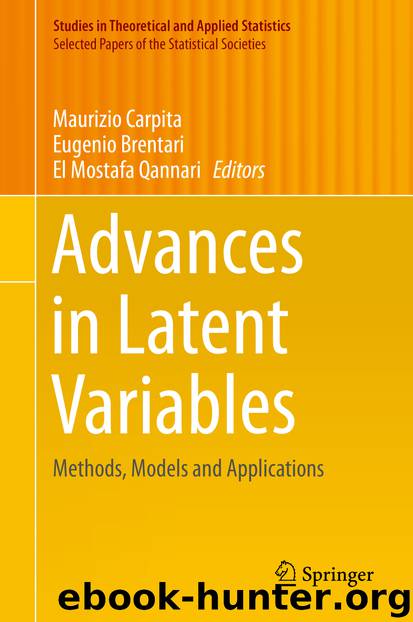Advances in Latent Variables by Maurizio Carpita Eugenio Brentari & El Mostafa Qannari

Author:Maurizio Carpita, Eugenio Brentari & El Mostafa Qannari
Language: eng
Format: epub
Publisher: Springer International Publishing, Cham
where θ = (β; ψ) is the list of the free parameters in the model of dimension t. The unknown parameters are estimated so that the implied covariance matrix is close to the observed sample covariance matrix S by using the Maximum Likelihood Estimation (MLE) criterion.
For the evaluation of the fitting we used the Standardized Root-Mean-square Residual (SRMR), a measure based on the differences between observed values (s) and model values (σ) of the covariance matrix:
SRMR values less than 0.10 are considered an adequate fitting approximation of the model to the data, whereas values < 0.05 may be judged as a good fit.
The respecification of the model was based on the inclusion of additional directed or bi-directed connections. All the original edges in the model were considered true as the KEGG database is manually curated by experts. The criteria used for the refinement were based on the combination of modification indexes (MI, an estimate of the decrease in the χ 2-score statistic that would result by freeing each fixed ( = 0) parameter in the model), z-tests ( = parameter estimate/standard error) of the MLE, combined with co-citation analysis. In synthesis, a path coefficient is added when, it is proposed by MI and it is possible to reveal a connection based on the co-citation analysis. This analysis is based on the concept that two genes, cited in the same papers, are very likely connected to each other. However, one of the principal question about the co-citation analysis is if the co-occurrences in titles and abstracts actually reflect meaningful relationships between genes. We assumed that the answer to this question is “yes”, also considering previous articles that treat this topic [17]. Different types of measures can be used to evaluate if two genes are connected [18]. We chose the Jaccard index, defined as the ratio between the articles (extracted from PubMed) where the two genes are co-cited together, divided by the union of the articles where the genes are cited together and singularly. A connection was considered acceptable if the Jaccard index, normalized for the number of genes, resulted greater than 0.5 [19]. The edges are added/deleted until a SRMR < 0.10 is reached. A multiple group analysis was performed on the final model to verify if it differed between the biological groups in the microarray. The test is based on the comparison of the fitted covariance matrix for each group, as reported below:
Download
This site does not store any files on its server. We only index and link to content provided by other sites. Please contact the content providers to delete copyright contents if any and email us, we'll remove relevant links or contents immediately.
International Integration of the Brazilian Economy by Elias C. Grivoyannis(91048)
The Radium Girls by Kate Moore(11921)
Turbulence by E. J. Noyes(7936)
Nudge - Improving Decisions about Health, Wealth, and Happiness by Thaler Sunstein(7615)
The Black Swan by Nassim Nicholas Taleb(7010)
Rich Dad Poor Dad by Robert T. Kiyosaki(6401)
Pioneering Portfolio Management by David F. Swensen(6226)
Man-made Catastrophes and Risk Information Concealment by Dmitry Chernov & Didier Sornette(5921)
Zero to One by Peter Thiel(5686)
Secrecy World by Jake Bernstein(4646)
Millionaire: The Philanderer, Gambler, and Duelist Who Invented Modern Finance by Janet Gleeson(4376)
The Age of Surveillance Capitalism by Shoshana Zuboff(4209)
Skin in the Game by Nassim Nicholas Taleb(4162)
Bullshit Jobs by David Graeber(4094)
The Money Culture by Michael Lewis(4076)
Skin in the Game: Hidden Asymmetries in Daily Life by Nassim Nicholas Taleb(3929)
The Dhandho Investor by Mohnish Pabrai(3699)
The Wisdom of Finance by Mihir Desai(3653)
Blockchain Basics by Daniel Drescher(3507)
